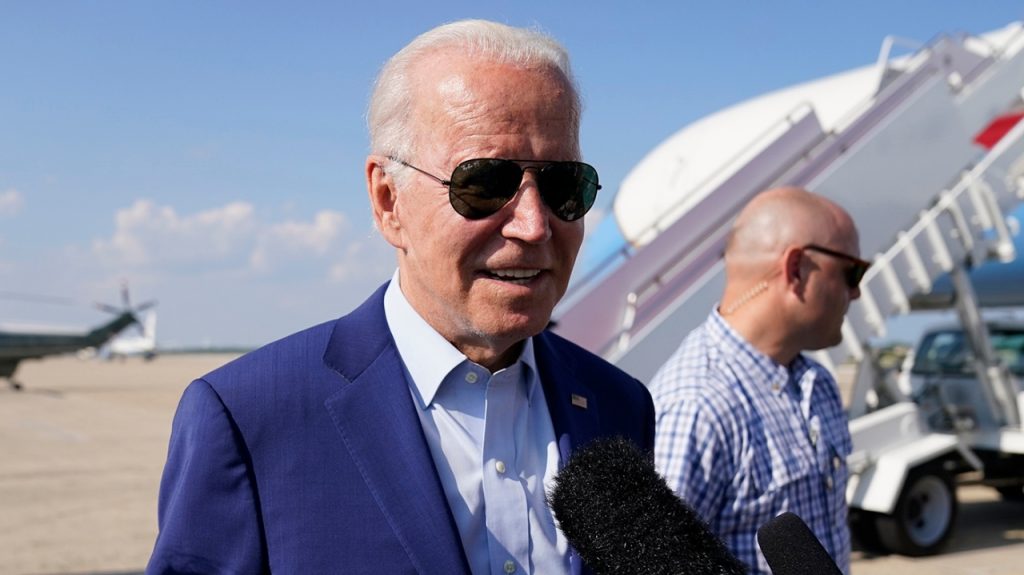
Five takeaways as Biden tests positive for COVID-19
President Biden tested positive for COVID-19 on Thursday, the latest development in the pandemic that continues to cast a shadow over his presidency. Here are five takeaways:
Biden’s age is the biggest risk factor
Even though he is up to date on his vaccines, including two boosters, Biden is 79 years old.
While deaths from COVID-19 are much lower now than during last winter’s peak, older Americans are much more susceptible to serious illness.
As of July 16, Centers for Disease Control and Prevention data showed 253 people aged 75 to 84 were dying each week, compared to only 57 people aged 55 to 64. The omicron variant has proven to be much more adept at evading immunity, especially among people who have not received both boosters.
While younger, healthier people are still well protected against severe disease, that hasn’t been the case for older Americans. Studies show the protection against infection from the initial series of vaccines starts to wane after about six months. That makes booster shots important, especially as most COVID-19 mitigation measures have ended.
Biden received his second booster in March.
“Because the president is fully vaccinated, double boosted, his risk of serious illness is dramatically lower,” Ashish Jha, the White House’s coronavirus coordinator, told reporters at a press briefing.
Biden’s infection is not a surprise
Most Americans have been infected with COVID-19.
“It’s actually striking to me how long it took Biden to get COVID, considering all his interactions with people, and oftentimes without any mask,” said Eric Topol, a molecular medicine professor and founder of the Scripps Research Translational Institute.
Biden’s positive test comes after he spent a week traveling through the Middle East, where he held meetings with foreign officials, shook hands and delivered fist bumps.
“We always knew this was a possibility, and I think the protocols have kept him from getting infected, but we knew that this was a possibility with this incredibly contagious variant,” Jha said.
The case underscores just how much more transmissible this version of the virus is. The omicron subvariant BA.5 makes up about 80 percent of all new infections in the U.S., according to the CDC, and is the most transmissible variant yet, though there’s no evidence it’s any more severe.
Members of Congress and Cabinet officials have all tested positive in recent weeks, including some for the second or even third time.
Biden’s positive test puts him in the company of his chief medical adviser Anthony Fauci, Vice President Harris, Senate Majority Leader Charles Schumer (D-N.Y.), Health and Human Services Secretary Xavier Becerra, Secretary of State Antony Blinken and Attorney General Merrick Garland, among others.
The infection marks the second time a president has contracted COVID-19
But Biden’s situation is far different than when former President Trump contracted the virus in 2020.
The biggest difference is the widespread availability of vaccines. In the fall of 2020, vaccines were not authorized and Trump was hospitalized for three days. It was later reported that Trump was in very serious condition.
Even though the vaccines are not as effective at blocking infections from new variants, they still “take death off the table,” said Topol.
Biden also has new treatment options to help fight the infection, including Pfizer’s antiviral pill, Paxlovid. The drug is about 90 percent effective at keeping high-risk people out of the hospital if taken within the first few days of symptoms.
Because of his age, Biden is considered high risk. He began a course of Paxlovid after his positive test.
Trump was treated with an experimental monoclonal antibody made by Regeneron, before it was officially cleared for emergency use by the Food and Drug Administration. The drug was only being used in clinical trials, though the company had the ability to grant access through compassionate use.
White House messaging not changing
White House officials on Thursday used President Biden’s positive test for COVID-19 to stress the importance of getting vaccinated and boosted against the virus.
The White House retooled its pandemic strategy last week in response to the BA.5 subvariant, though it largely was not any different from what the administration had been doing for months.
Prior to Biden’s positive test, White House officials in recent weeks have worked to balance the message about being wary about rising infections, but not overly so.
“We should not let it disrupt our lives, but we cannot deny that it is a reality we need to deal with,” Fauci said at a White House press briefing last week.
Masks are not required in the White House. Jha on Thursday said the White House will continue to follow CDC guidelines in terms of masking. CDC recommends people in “high risk” counties wear masks indoors.
The latest agency data puts about 35 percent of United States counties in the “high risk” category, but those counties are home to about 55 percent of the American population.
COVID-19 is still surging
While the pandemic is no longer at the top of people’s minds, Biden’s infection shows the virus is still a threat. Cases and hospitalizations are rising across the nation.
“A reminder to all: this pandemic is not over and COVID-19 is still spreading. If you haven’t gotten your vaccine and/or booster shot, please do,” Sen. Tammy Duckworth (D-Ill.) said in a tweet.
As of Wednesday, an average of roughly 126,000 coronavirus cases and 350 deaths were being reported each day in the United States, according to the CDC. Yet the number of new infections is also likely an undercount due to at-home testing.
“I don’t believe that every American will be infected,” Jha said, but because of how transmissible the variant is, many Americans have already been infected.
He acknowledged the need for virus mitigation measures, but said the White House strategy is working.
Public health officials are also wary of sounding the alarm, even though cases and hospitalizations are up.